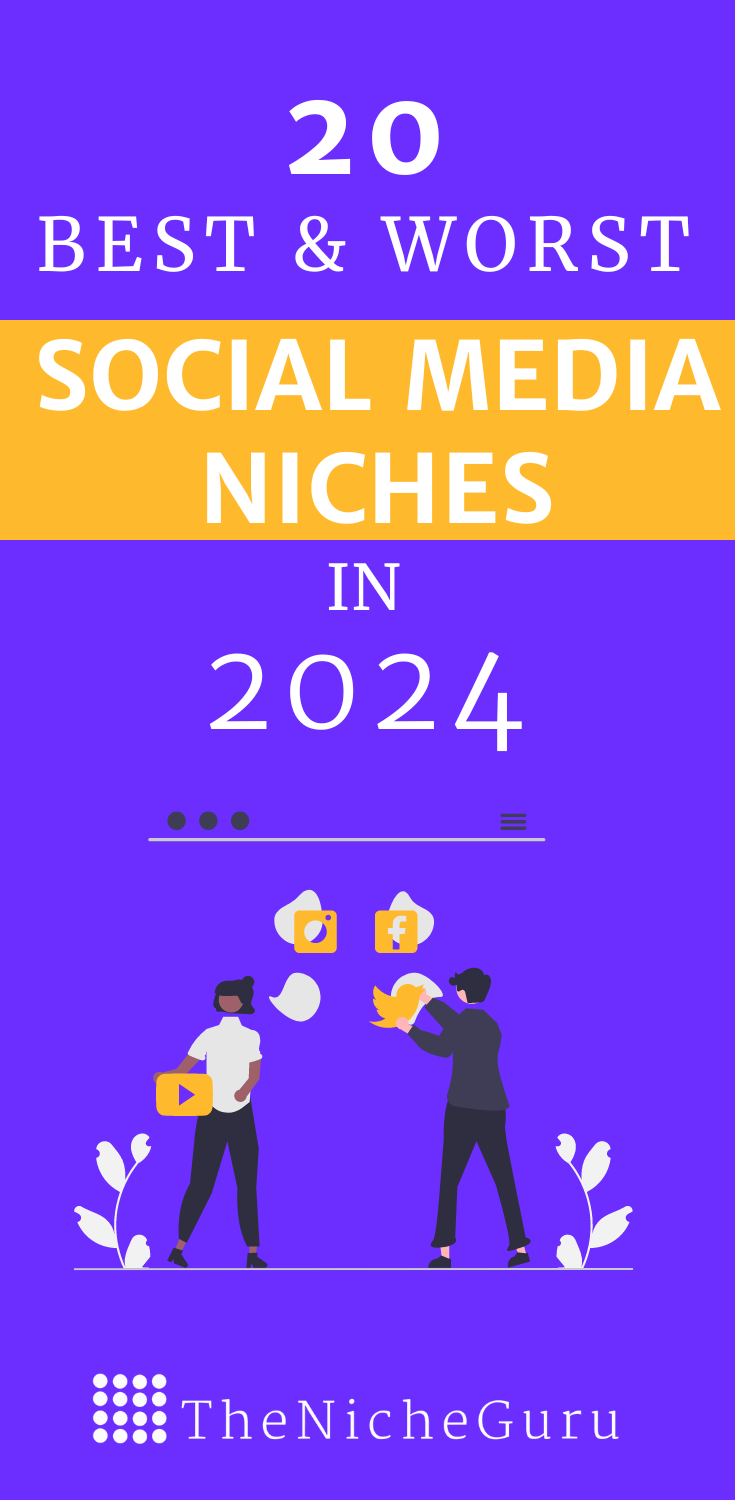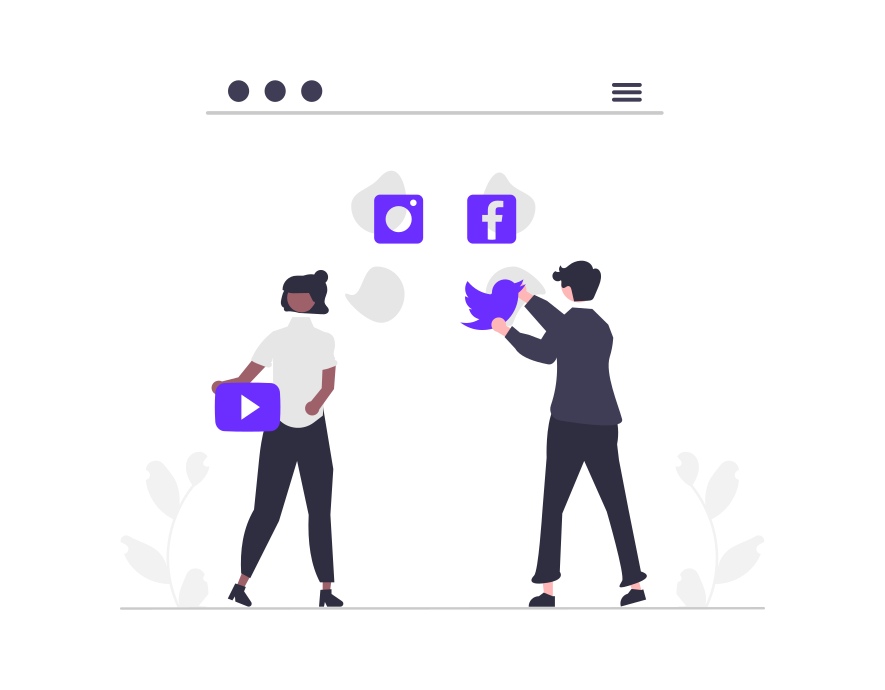Struggling to find the sweet spot in social media niches? It’s a tricky game, choosing the right niche. Pick wrong, and you’re shouting into the void; no likes, shares, or comments.
Here’s a staggering fact: 24% of businesses admit that generating traffic and leads is their top marketing challenge, according to HubSpot. This often stems from a mismatch in niche selection. Imagine this – you invest time and resources in a niche, but it’s oversaturated or just doesn’t resonate with your audience. Frustrating, right?
But fear not! In this article, I willto light up the path. I’ll explore each major social media platform – YouTube, Instagram, Pinterest, Facebook, and TikTok – and break down the best and worst niches for each. You won’t just get a list; you’ll understand the ‘whys’ behind each niche’s success or flop.
So, are you ready to align your brand with the perfect niche? Let’s get the ball rolling!
- What is a Social Media Niche?
- Why Niche Down? Unlock the Power of Focus
- 1. Targeted Audience to Laser-Focus Your Message
- 2. Less Competition to Stand Out in the Crowd
- 3. Greater Engagement to Foster a Community
- 4. Enhanced Brand Identity to Shape Your Unique Story
- 5. Efficient Resource Use to Maximize Your Marketing Spend
- 6. Higher Conversion Rates to Turn Followers into Customers
- The Impact of Choosing Right (or Wrong)
- The List of Social Media Niches
- Pro tip: How Do I handle several platforms efficiently?
- Wrapping It Up: Your Social Media Niche Guide
*Disclosure: I only recommend products I would use myself, and all opinions expressed here are my own. This post may contain affiliate links that at no additional cost to you, I may earn a small commission.
What is a Social Media Niche?

Ever wondered why some brands seem to have a cult following on social media, while others barely get noticed? It’s all about finding your niche.
A social media niche is essentially your brand’s sweet spot. It’s where your unique content intersects with a specific audience’s interests. Think of it as your digital neighborhood, where you’re not just another face in the crowd.
- Targeted Content: Imagine you’re a food blogger like @veggiekins focusing on vegan recipes. That’s your niche. You’re not just another food enthusiast; you’re specifically catering to vegan food lovers.
- Engaged Community: In this niche, your followers aren’t just anyone interested in food; they’re specifically looking for plant-based options. Your recipes, tips, and food choices speak directly to their lifestyle and values.
- Unique Identity: This focus sets you apart. Among thousands of food bloggers, you’re the go-to source for vegan cooking, offering unique value to a specific group of food enthusiasts.
Nailing your social media niche means more than just picking a category. It’s about aligning your brand’s voice and content with the specific needs and interests of a defined audience.
Why Niche Down? Unlock the Power of Focus
Thinking of casting a wide net on social media? Hold that thought. Niche marketing might just be your secret weapon. Here’s why honing in on a specific niche can be a game-changer:
- Specificity Matters: When you niche down, you’re talking directly to a select group. For instance, if you’re in fitness, targeting ‘yoga enthusiasts over 40’ instead of just ‘people who exercise’ can skyrocket your relevance.
- Pro Tip: Use tools like Google Trends or BuzzSumo to research your niche’s interests and pain points. This ensures your content hits home every time.
- Stat to Consider: A study by the Content Marketing Institute shows that 80% of marketers attribute their success to more targeted content creation.
- Be the Go-To Source: In a smaller niche, your brand can quickly become the authority. This means you’re not just another voice; you’re the voice.
- Quality Over Quantity: Niche audiences may be smaller, but they’re mighty in engagement. These followers are more likely to interact, share, and advocate for your brand.
- Actionable Insight: Engage with your audience. Run polls, ask questions, and create content that encourages user interaction. This builds a community, not just a following.
- Craft a Distinct Voice: A niche allows you to develop a unique brand personality. For example, focusing on ‘sustainable fashion’ can position you as a pioneer in environmental stewardship.
- Tool for Clarity: Use platforms like Canva or Adobe Spark to create consistent visual branding that resonates with your niche audience. This visual consistency strengthens your brand’s identity.
- Cost-Effective Strategies: When your target audience is well-defined, your marketing efforts (and dollars) become more efficient. You’re not spreading resources thin across a broad audience but investing in a focused group.
- Stat Alert: According to McKinsey, personalized niche marketing can reduce your advertising costs by 50% due to more targeted ad campaigns.
- Tailored Content = More Sales: In a niche market, your content is tailored to the needs and desires of your audience. This relevance boosts the likelihood of converting followers into customers.
- Case Study Insight: Brands like Glossier have thrived by focusing on niche markets, boasting a conversion rate significantly higher than industry averages.
Remember: Picking your niche isn’t just about what you’re passionate about. It’s also about where you can add unique value. Think of your niche as your brand’s fingerprint – distinct and unique.
The Impact of Choosing Right (or Wrong)
Navigating the social media landscape can be like a tightrope walk. Make the right choice, and you soar; the wrong one, and it’s a long fall. Let me break it down:
Consider the success of ‘Lush Cosmetics’. By focusing on handmade, cruelty-free beauty products, they’ve carved a niche that resonates deeply with an environmentally conscious audience.
It’s about creating value. As an expert in eco-friendly beauty products, you’re not just a seller; you’re a problem solver, an educator, and a trusted advisor.
Pro Tip: Utilize analytics tools like Google Analytics or Facebook Insights to continuously monitor and understand your niche audience. This data-driven approach helps refine your strategy for even greater impact.
A generic approach might seem safe, but it’s risky. Without a niche, your message is likely to get lost in the noise. It’s akin to shouting into a void where your voice is drowned out by a multitude of others.
Stat Alert: According to a survey by CoSchedule, marketing experts who effectively plan their campaigns are 356% more likely to report success. A well-defined niche is a cornerstone of this planning.
Leverage tools like SEMrush or Ahrefs to conduct competitive analysis. Understanding what works (and what doesn’t) in your chosen niche can prevent you from falling into the trap of being too generic.
In essence, the right choice in social media niches propels you to thought leadership and customer loyalty, while the wrong choice can render your efforts invisible.
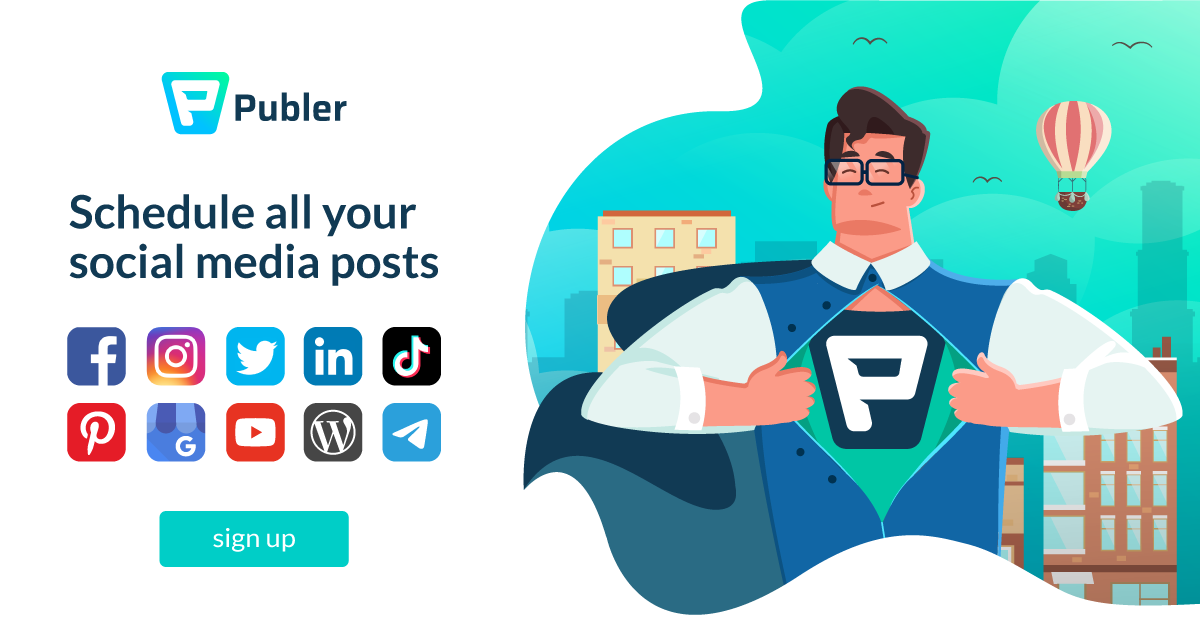
The List of Social Media Niches
Navigating the vast ocean of social media, I’ve come to realize that each platform has its unique flavors and pitfalls. Let’s start with YouTube, a powerhouse of content variety.
YouTube Niches
YouTube, the king of video content, offers a plethora of niches, but not all are created equal. Here’s my take on the four best and four worst niches on YouTube, complete with examples to paint a clearer picture.
The Best:
Here are some of the best YouTube niches:
1. Educational Content (e.g., Kurzgesagt – In a Nutshell)
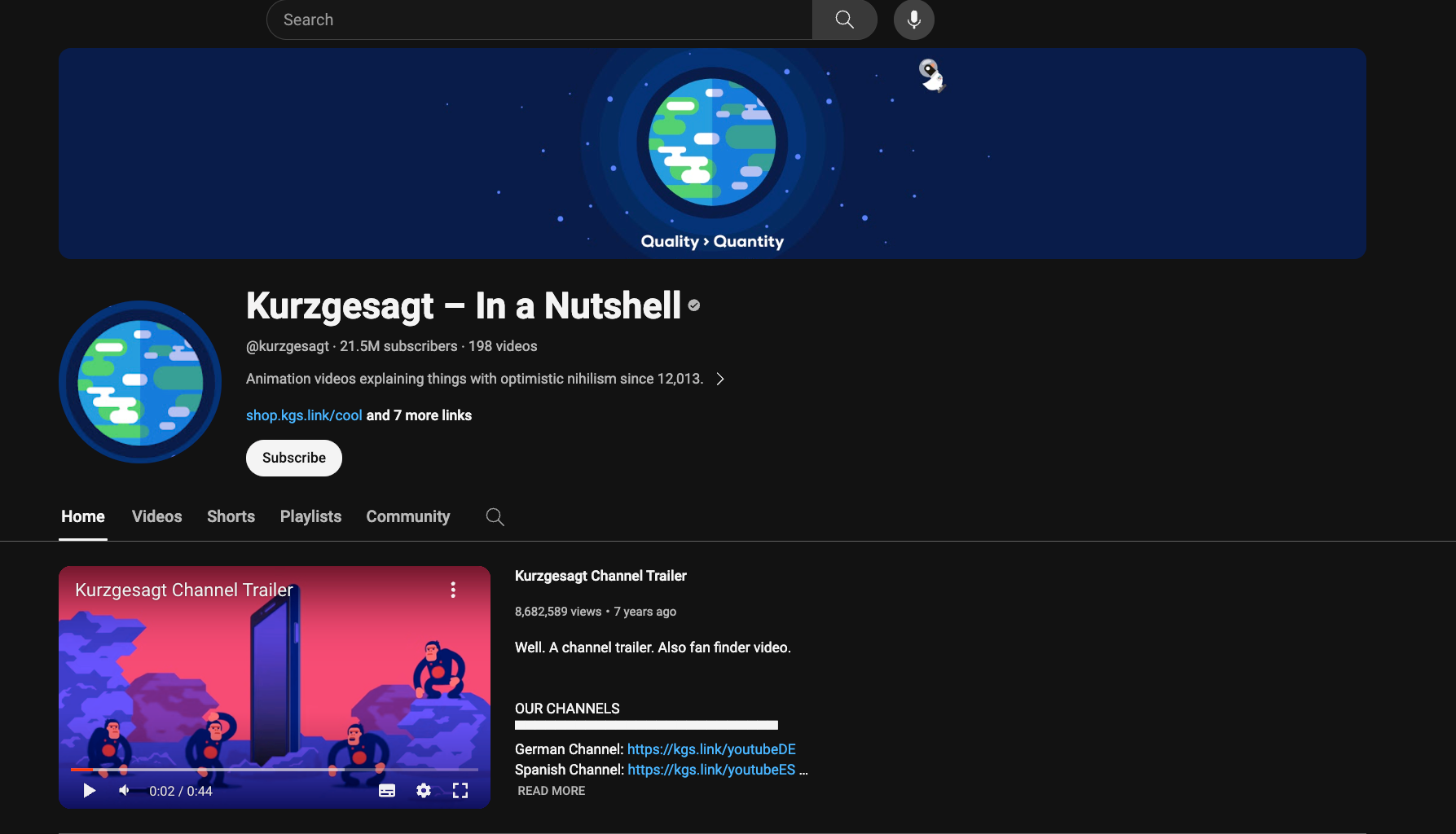
Content that educates and informs tends to have a lasting impact. It’s about offering value that keeps viewers coming back.
Why It’s the Best?
- High Retention Rates: Viewers often return for valuable, informative content.
- Diverse Audience Appeal: Appeals to various age groups and interests.
- Opportunity for Collaboration: Potential partnerships with educational institutions or brands.
- Evergreen Content: Educational videos often remain relevant, driving long-term traffic.
2. Tech Reviews (e.g., Marques Brownlee)
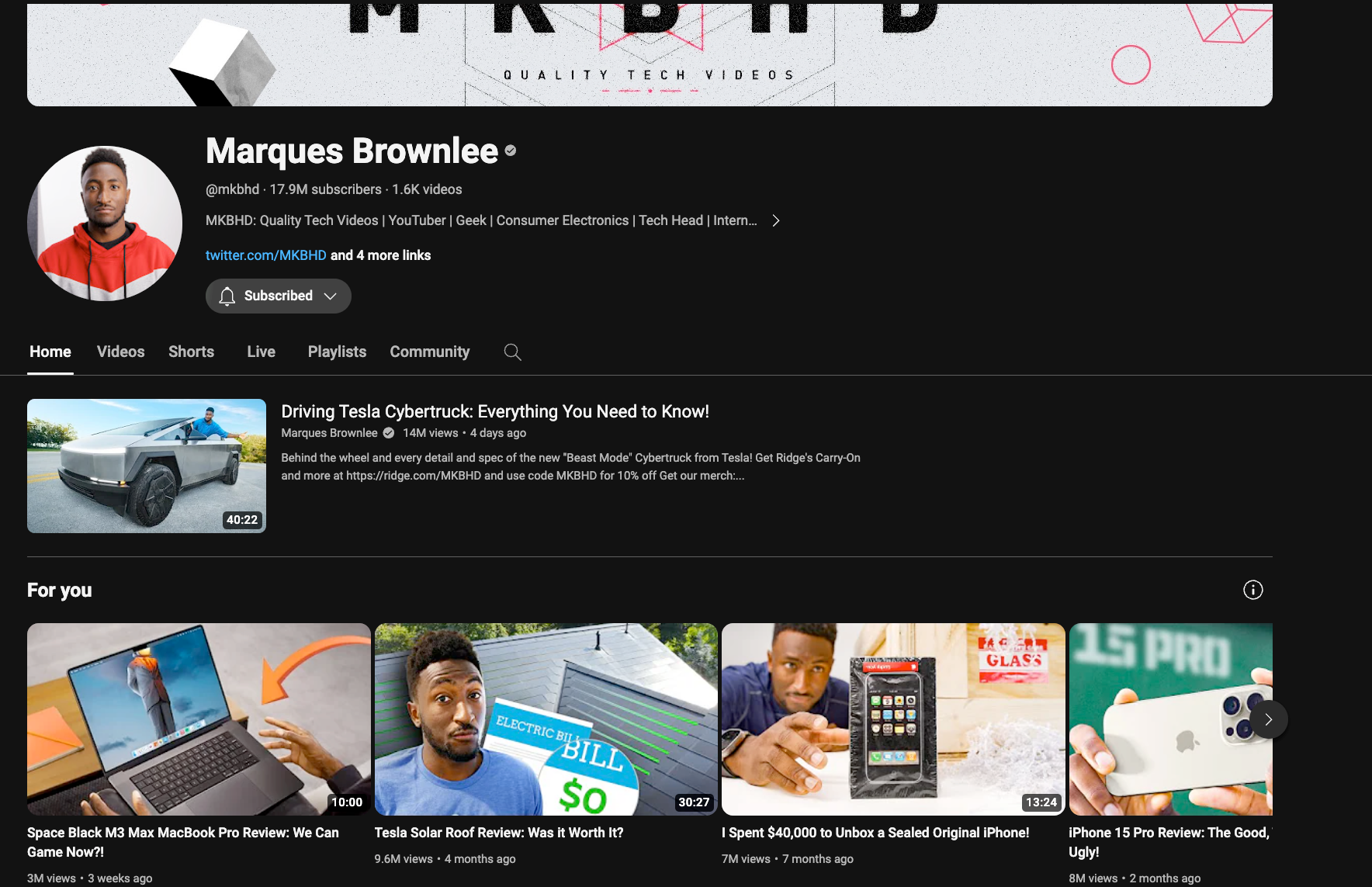
With technology constantly evolving, there’s a hungry audience always seeking the latest gadget reviews and tech insights.
Why It’s the Best?
- Growing Tech Interest: Constant tech advancements keep the audience engaged.
- Affiliate Marketing Opportunities: Potential for monetization through affiliate links.
- High Engagement: Tech enthusiasts love to discuss and debate in comments.
- Brand Collaboration Potential: Attracts sponsorships from tech companies.
3. Health and Fitness (e.g., FitnessBlender)
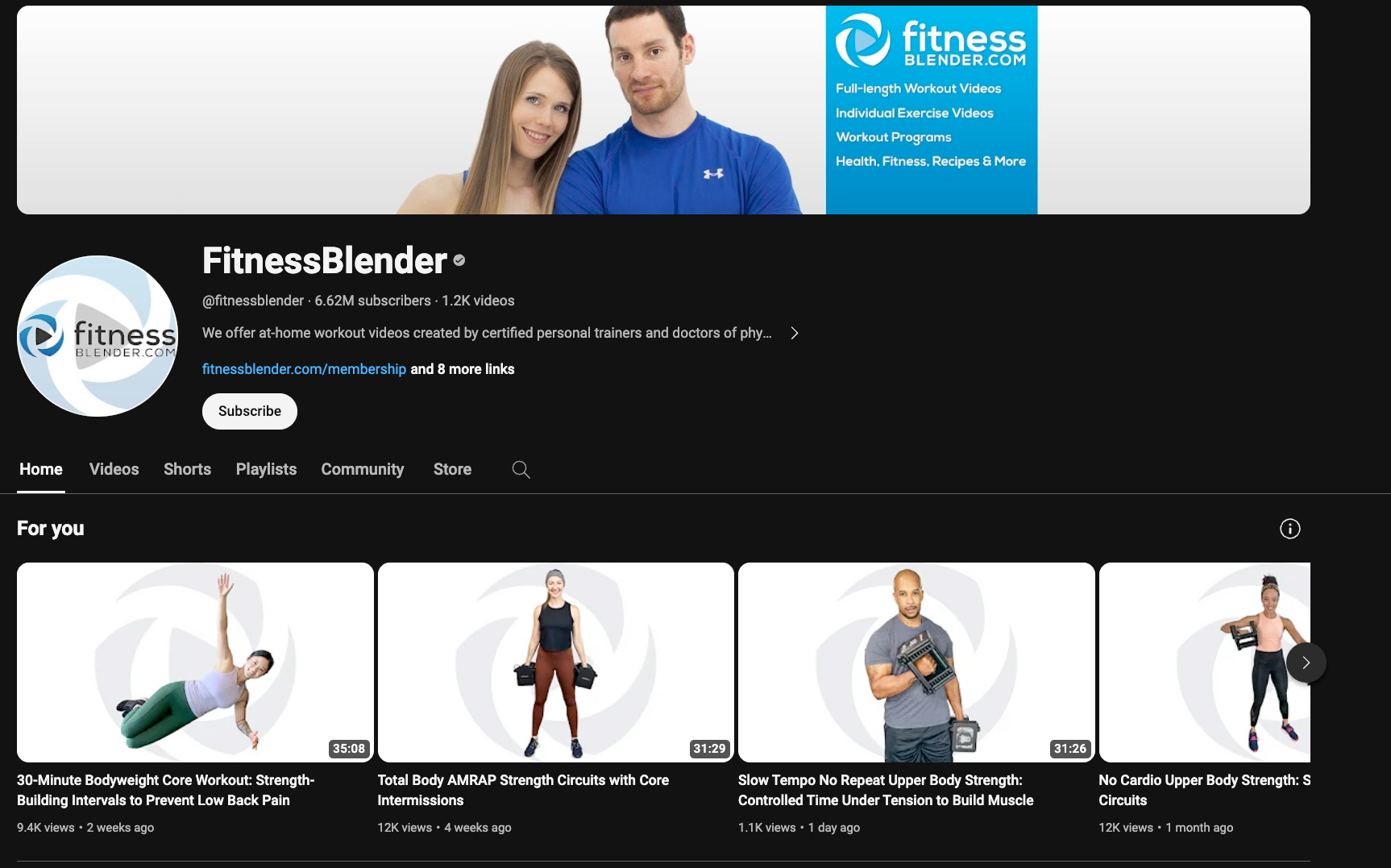
People are increasingly turning to YouTube for workout routines, fitness tips, and health advice – a niche that’s both evergreen and engaging.
Why It’s the Best?
- Growing Health Consciousness: Increasing interest in fitness and wellness.
- Diverse Content Opportunities: From workouts to nutrition advice, the options are vast.
- Community Building: Engaged followers passionate about fitness journeys.
- Brand Partnerships: Opportunities for partnerships with health and fitness brands.
4. Travel Vlogging (e.g., Nomadic Matt)
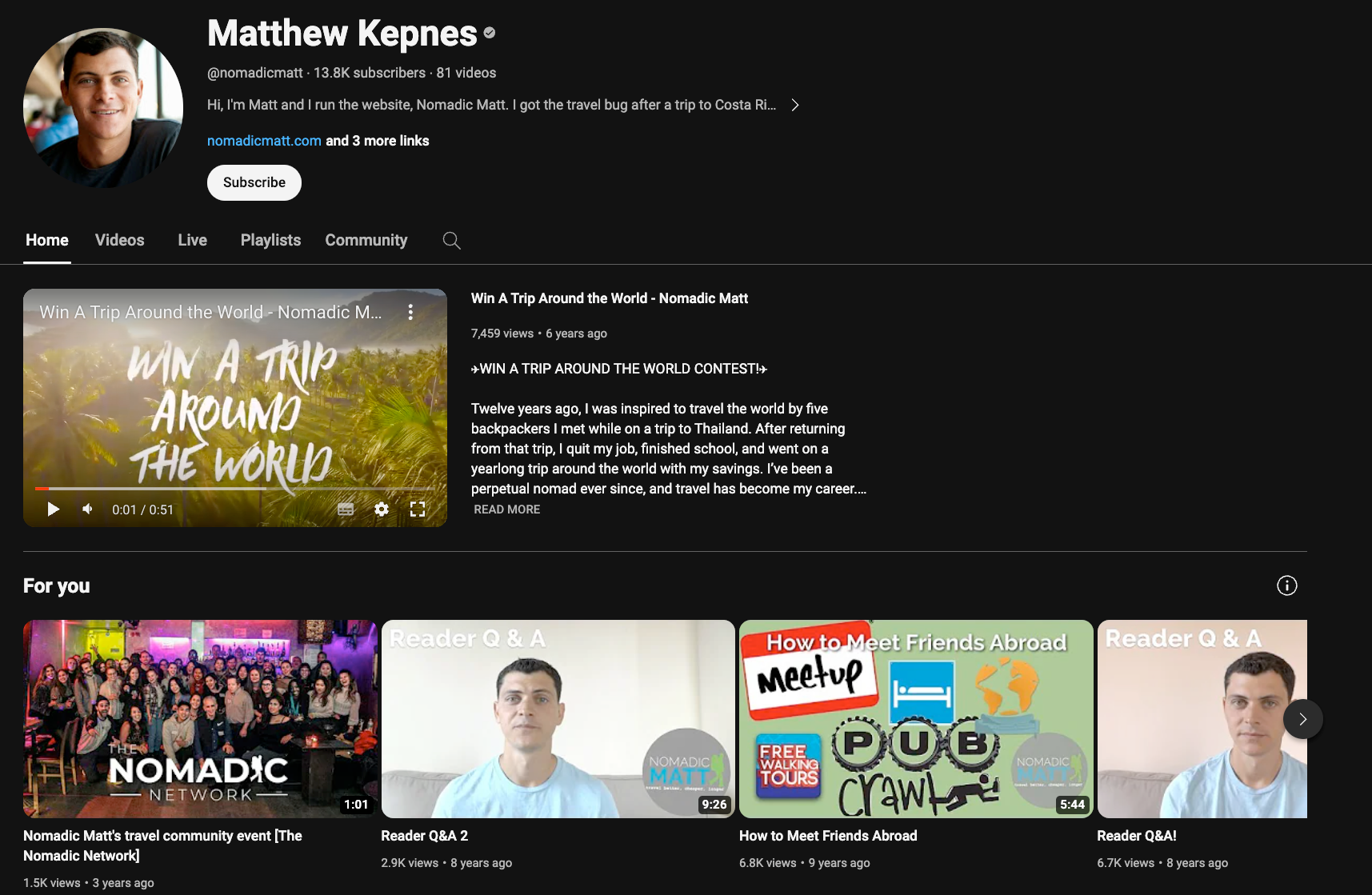
Everyone loves to travel vicariously through others. Travel vlogs offer escapism and practical tips, attracting a wide range of viewers.
Why It’s the Best?
- Visual Appeal: Travel content is inherently visually captivating.
- Escapism and Inspiration: Offers viewers a break from their daily routine.
- Sponsorship and Affiliate Opportunities: Potential for travel-related brand deals.
- Broad Audience Reach: Appeals to various demographics and interests.
The Worst:
The worst ones you should not go for are:
1. Overly Broad Lifestyle Vlogs
While lifestyle niche can be engaging, being too broad makes it hard to build a dedicated audience. It’s like being a jack of all trades but master of none.
Why It’s the Worst?
- Lack of Specific Audience: Difficult to target and retain a specific viewer base.
- Inconsistent Engagement: Viewers may only tune in for certain topics.
- Brand Identity Issues: Harder to establish a unique brand identity.
- Lower Search Relevance: Broad topics are less likely to rank in specific searches.
2. Controversial Opinion Channels
While controversy can generate initial clicks, it often leads to a toxic environment, which is not sustainable or brand-friendly in the long run.
Why It’s the Worst?
- Short-Lived Attention: Initial clicks may not translate to long-term engagement.
- Brand Risk: Potential to alienate advertisers and sponsors.
- Community Toxicity: Often breeds a negative comment environment.
- Potential for Demonetization: Risk of falling foul of YouTube’s content policies.
3. Rehashed Viral Content
Simply regurgitating content that’s already viral doesn’t add value. It might bring in some views, but lacks originality and staying power.
Why It’s the Worst?
- Limited Originality: Fails to offer new perspectives or value.
- Short-Term Traffic: Lacks sustainability for long-term audience growth.
- Low Audience Loyalty: Viewers are less likely to subscribe for more content.
- High Competition: Many channels often chase the same viral trends.
4. Poorly Produced Comedy
Comedy is subjective and hard to get right. Poor production quality or humor that misses the mark more often than not leads to a quick exit by viewers.
Wh[[y It’s the Worst?
- Subjective Appeal: Risk of humor not resonating with a wide audience.
- Quality Expectations: Viewers have high standards for production and content quality.
- Inconsistent Virality: Hard to predict what will resonate with viewers.
- High Competition: Comedy is a saturated niche on YouTube.
Navigating YouTube’s niches has taught me a great deal about the importance of adding value and carving out a distinct space in the viewer’s world.
Instagram Niches
Now, let’s turn our focus to Instagram, a platform synonymous with visual storytelling and trendsetting. Instagram is a vibrant canvas for creators, influencers, and businesses alike. Its visually rich environment and engaged user base make it ideal for the most profitable Instagram niches that prioritize aesthetics and storytelling. Here, certain niches not only survive but truly flourish, while others struggle to make an impact.
Let’s explore the profitable Instagram niche ideas and some not-so-profitable niche ideas, diving into what makes them a hit or a miss in this visually-driven social landscape.
The Best:
Here’s the list of best Instagram niches:
1. Travel and Adventure Photography (e.g., @travelandleisure)
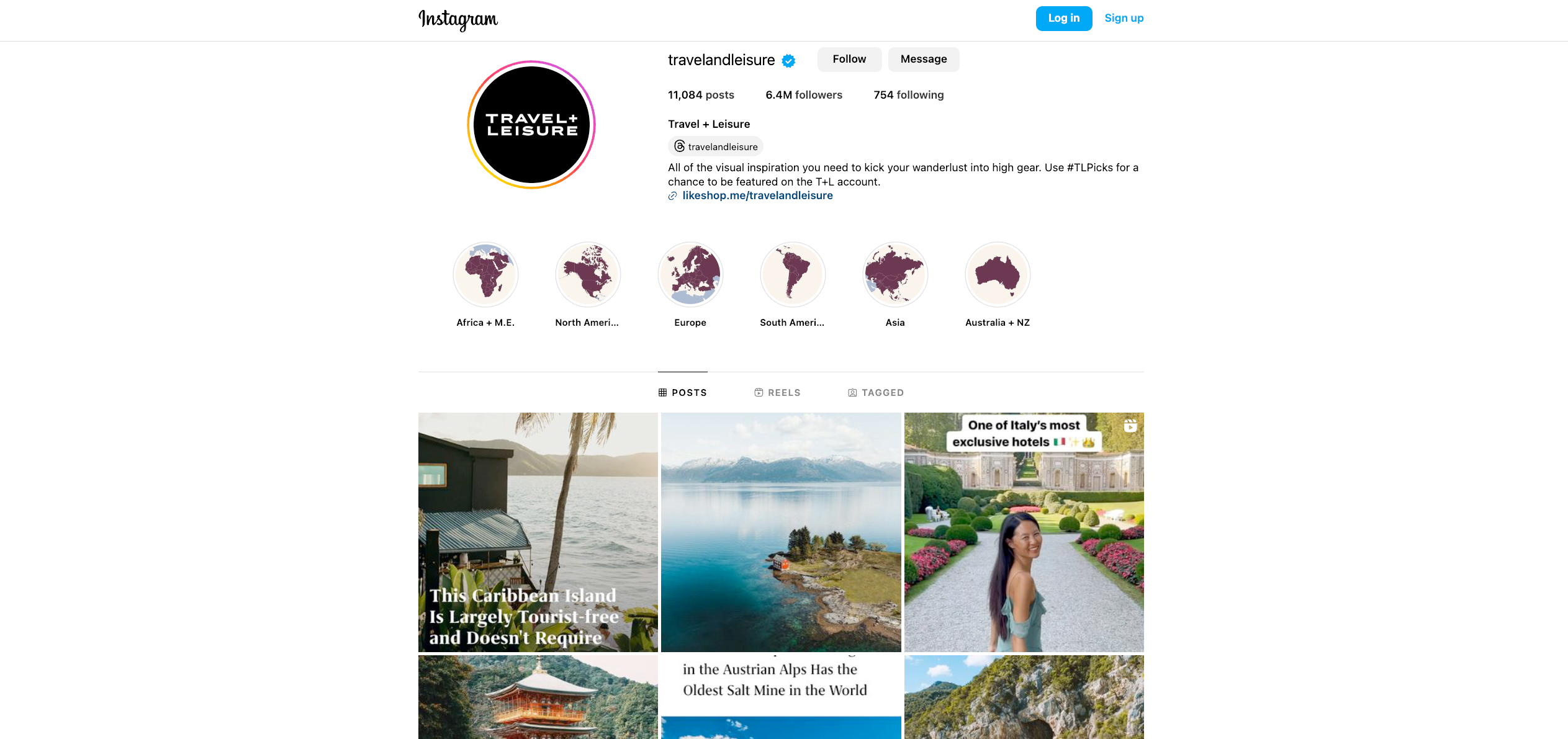
Stunning travel and adventure photography captures the essence of Instagram’s visual appeal.
Why It’s the Best?
- High Visual Impact: Captivating images that draw in viewers.
- Wide Appeal: Attracts a broad audience of travel enthusiasts.
- Influencer Potential: Great opportunities for collaborations and sponsorships.
- Engaging Storytelling: Allows for captivating narratives around travel experiences.
2. Fashion and Lifestyle Influencing (e.g., @modeblogg)
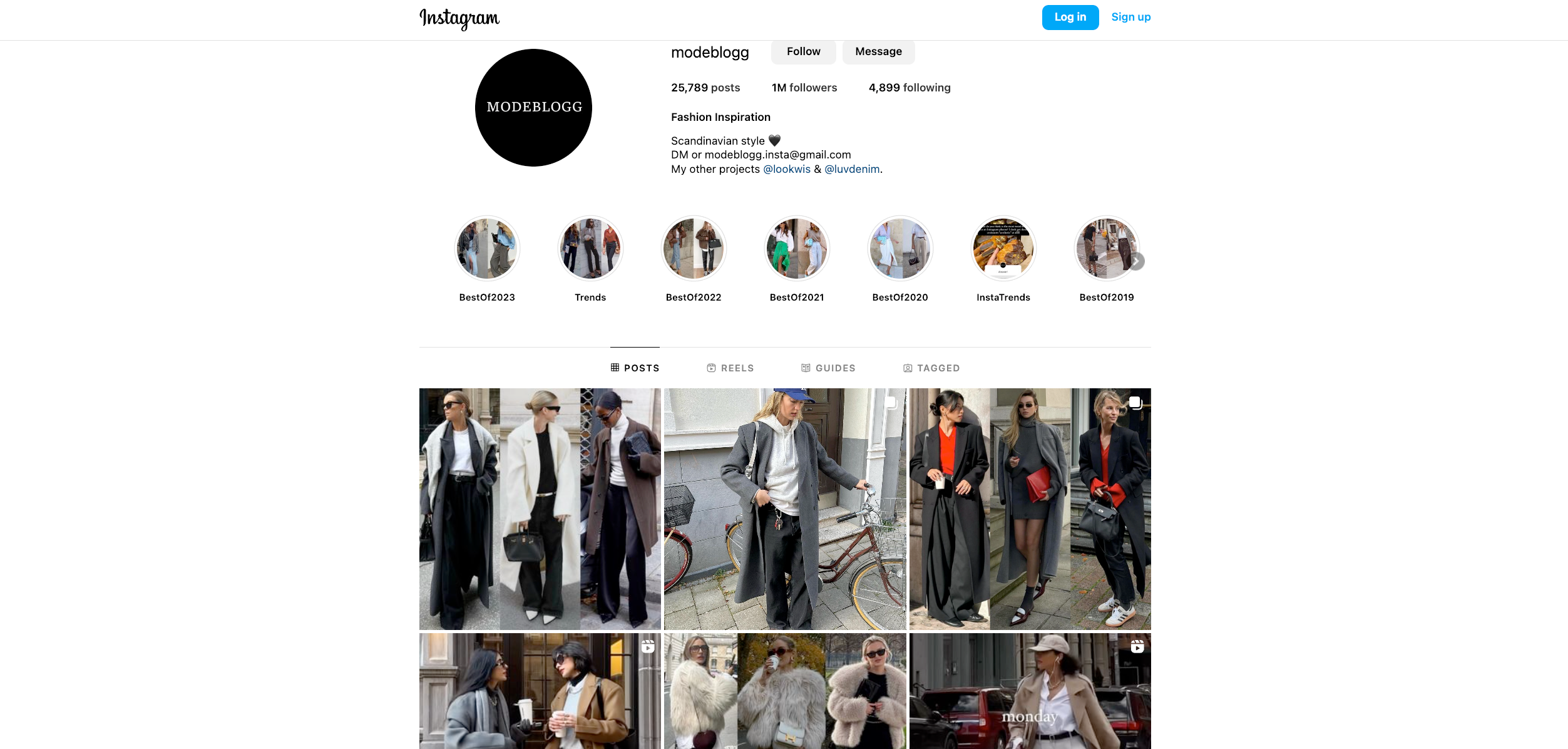
Fashion and lifestyle niches are the cornerstones of Instagram, showcasing trends, styles, and day-to-day elegance.
Why It’s the Best?
- Trendsetting Platform: Ideal for showcasing the latest fashion trends.
- Brand Collaborations: High potential for partnerships with fashion and lifestyle brands.
- Engagement with Followers: Personal-style stories resonate with a wide audience.
- Visual and Influential: Perfect for Instagram’s image-focused format.
3. Food Photography and Culinary Arts (e.g., @love_food)
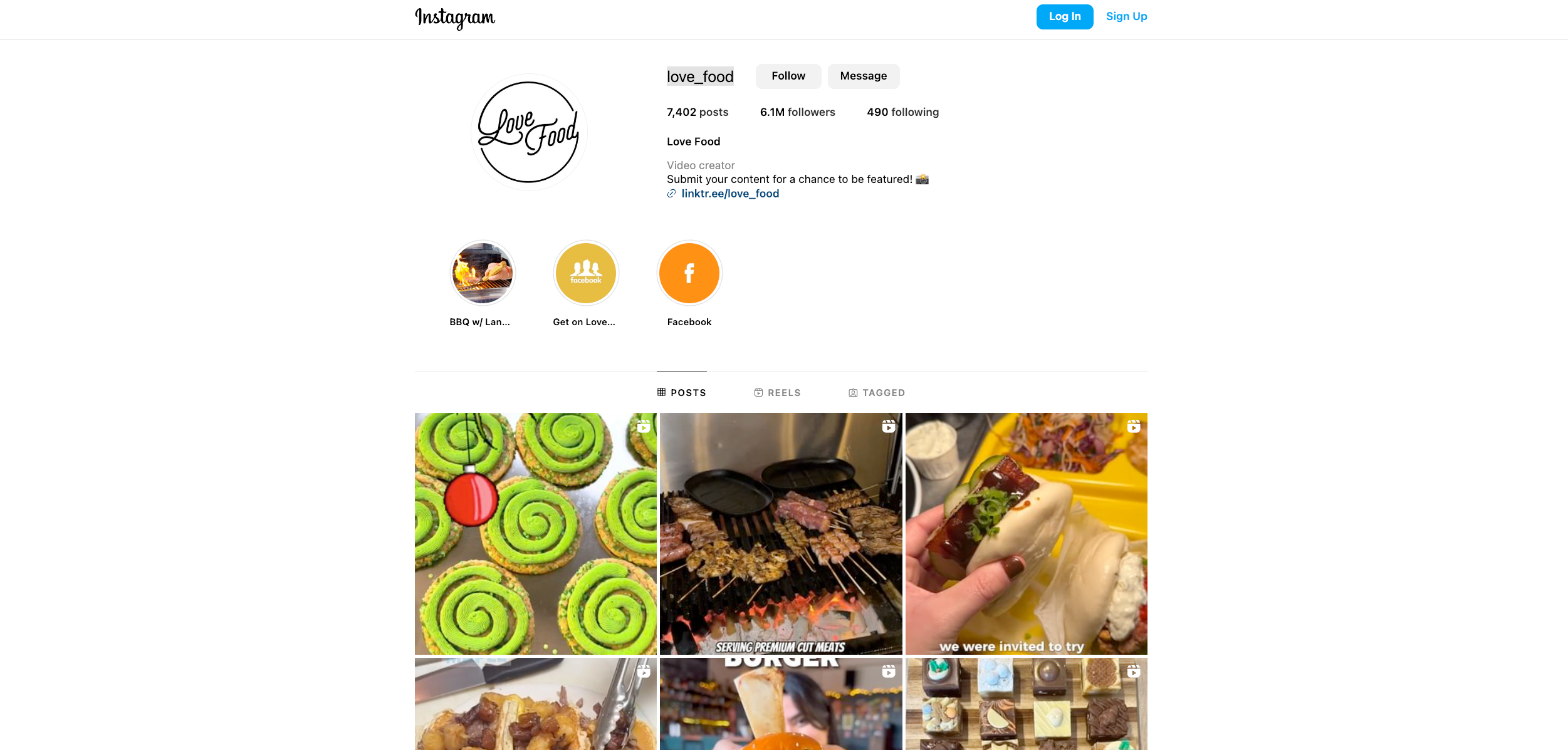
Instagram is a foodie’s paradise, with food photography and culinary arts taking center stage.
Why It’s the Best?
- Appetizing Visuals: Food images are inherently engaging and shareable.
- Diverse Culinary Content: Appeals to a wide range of food enthusiasts.
- Restaurant and Brand Promotion: Great for chefs, restaurants, and food brands.
- Interactive Content: Recipe sharing, cooking tips, and foodie meet-ups.
4. Fitness and Wellness Journey (e.g., @muscleandfitness)

Fitness and wellness content on Instagram is not just about workouts but inspiring lifestyle changes.
Why It’s the Best?
- Motivational Stories: Personal journeys and transformations are highly engaging.
- Health and Fitness Trends: Showcasing popular workouts, wellness tips, and healthy habits.
- Community Building: Encourages interaction and support among followers.
- Brand and Product Endorsements: Ideal for fitness and wellness product promotions.
The Worst:
The worst Instagram niches to avoid include:
1. Overly Technical or Industrial Content
Content that is too technical or industrial often fails to resonate with Instagram’s visually-driven audience and ends up not being a successful Instagram account.
Why It’s the Worst?
- Visual Mismatch: Lacks the aesthetic appeal that Instagram users seek.
- Limited Engagement: Such content typically attracts less interaction.
- Niche Audience: Appeals to a very specific and limited group.
- Difficult to Showcase: Challenging to present in an engaging, visual format.
2. Heavy Text-Based Content
Instagram’s format isn’t conducive to lengthy, text-heavy posts, making this type of content less effective.
Why It’s the Worst?
- Visual Platform: Users prefer images and videos over large amounts of text.
- Lower User Interaction: Text posts are often scrolled past in favor of visual content.
- Format Limitations: Difficult to convey detailed information in a visually appealing way.
- Reduced Shareability: Less likely to be shared compared to compelling images or videos.
3. Political and Controversial Topics
While important, political and controversial topics often face challenges in Instagram’s lifestyle-centric environment.
Why It’s the Worst?
- Polarizing Nature: Can create divisiveness among followers.
- Misalignment with Platform Mood: Instagram is largely used for leisure and inspiration.
- Engagement Risks: Risk of negative comments and reduced brand affinity.
- Algorithmic Challenges: May be less favored by Instagram’s content algorithms.
4. Hard-Sell Advertising
Direct, hard-sell advertising strategies can be off-putting on a platform that values storytelling and authenticity.
Why It’s the Worst?
- Audience Resistance: Users often disengage from overtly promotional content.
- Disrupts User Experience: Breaks the flow of organic, engaging content.
- Trust Erosion: Can diminish the perceived authenticity of the account.
- Algorithmic Disadvantages: May be deprioritized by Instagram’s algorithm.
In understanding a very profitable Instagram niche, it becomes clear that the platform rewards content that is visually captivating, authentic, and engaging. While it offers vast opportunities for creative expression and connection, aligning with the platform’s strengths is key to making a profitable Instagram account.
Pinterest Niches
Moving onto Pinterest, the visual discovery engine, I’ve observed it’s a platform where creativity meets practicality. Pinterest is a unique beast in the social media jungle, thriving on stunning visuals and inspiring ideas. It’s not just about what’s trending; it’s about what’s useful, beautiful, and share-worthy.
Let’s dive into the four best and four worst niches, starting with the best.
The Best:
Here’s the list of best ones that are worth considering:
1. Home Decor and Renovation (e.g., Home & Decor SG)
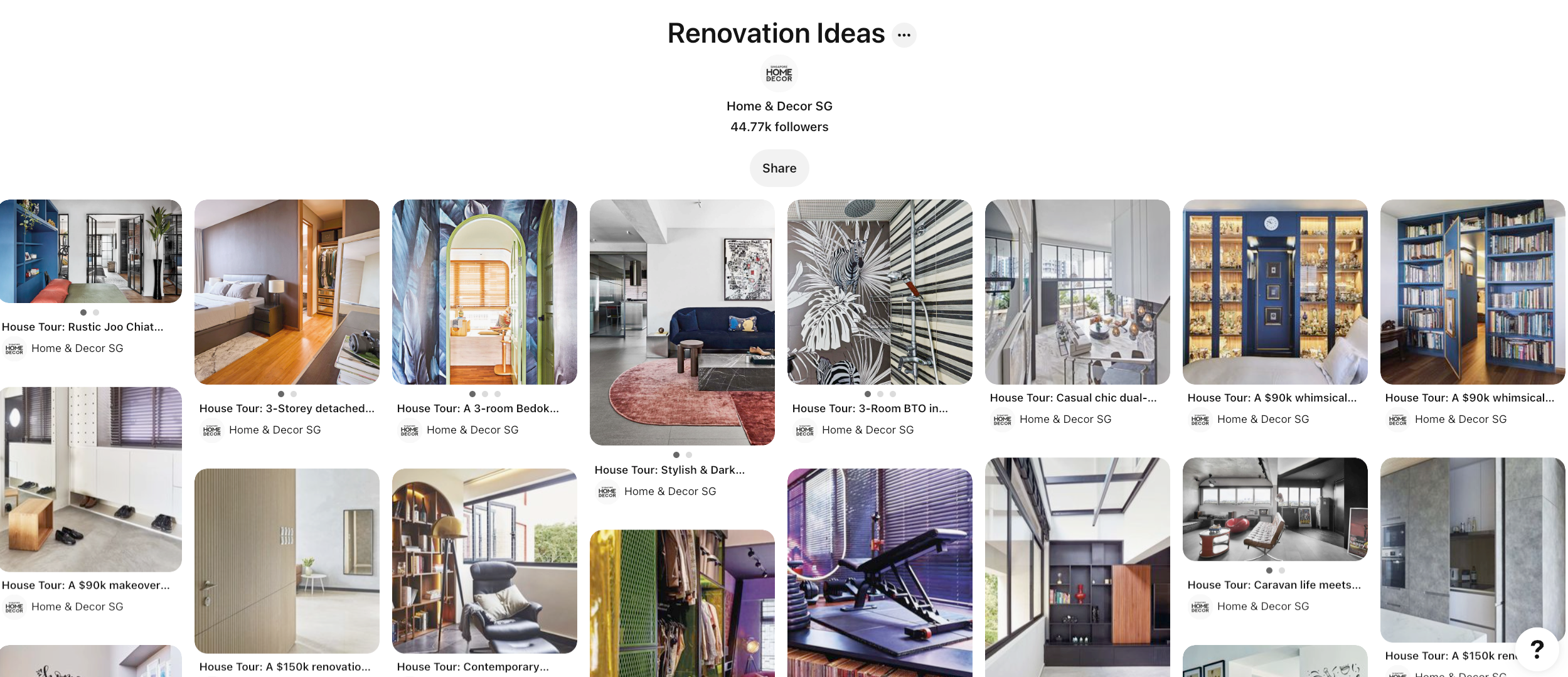
Home decor and renovation is a niche that resonates deeply on Pinterest. It’s all about transforming spaces, be it a cozy corner in a studio apartment or a complete home makeover. This niche caters to a wide range of interests, from minimalistic designs to extravagant renovations, capturing the imagination of anyone looking to beautify their living space.
Why It’s the Best?
- Highly Visual Content: Perfectly aligns with Pinterest’s image-focused platform.
- Diverse Audience Reach: Attracts DIY enthusiasts, professional designers, and everyday homeowners.
- Engagement Booster: Ideas in this niche are often saved and revisited, leading to high user engagement.
- Monetization Opportunities: Great potential for affiliate marketing with home decor brands and products.
2. Health and Wellness Recipes (e.g., Ali Williams)
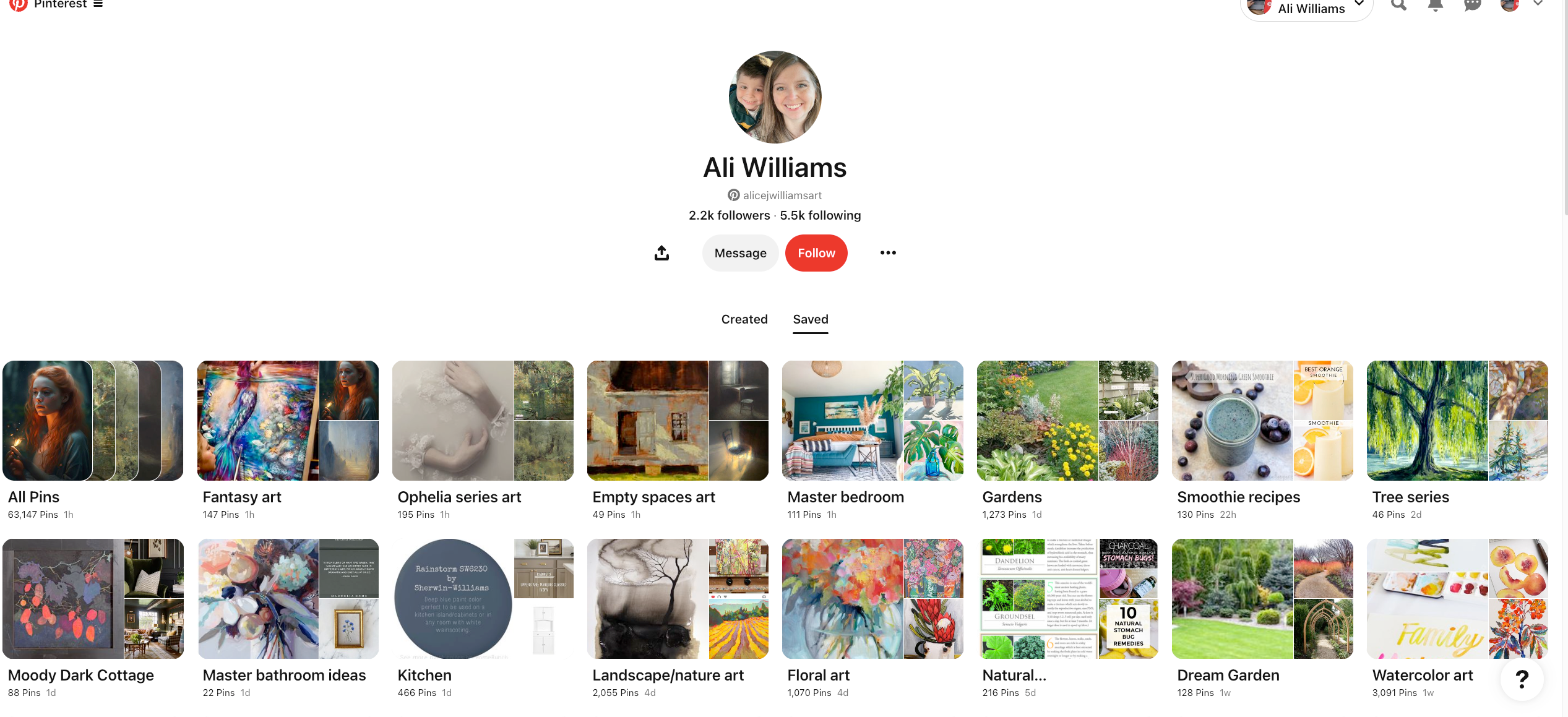
In the health and wellness recipes niche, Pinterest users find a treasure trove of nutritious and delicious meal ideas. This niche serves up everything from quick healthy snacks to elaborate fitness-friendly meals, catering to the health-conscious and culinary adventurers alike.
Why It’s the Best?
- Aligns with Health Trends: Meets the growing demand for healthier living and eating.
- Highly Shareable: Recipes are among the most saved and shared content on Pinterest.
- Visually Appealing and Practical: Combines beautiful food photography with actionable recipes.
- Brand Partnership Potential: Ideal for collaborations with health and wellness niche influencers and brands.
3. DIY Crafts and Projects (e.g., Soap Deli News Blog)
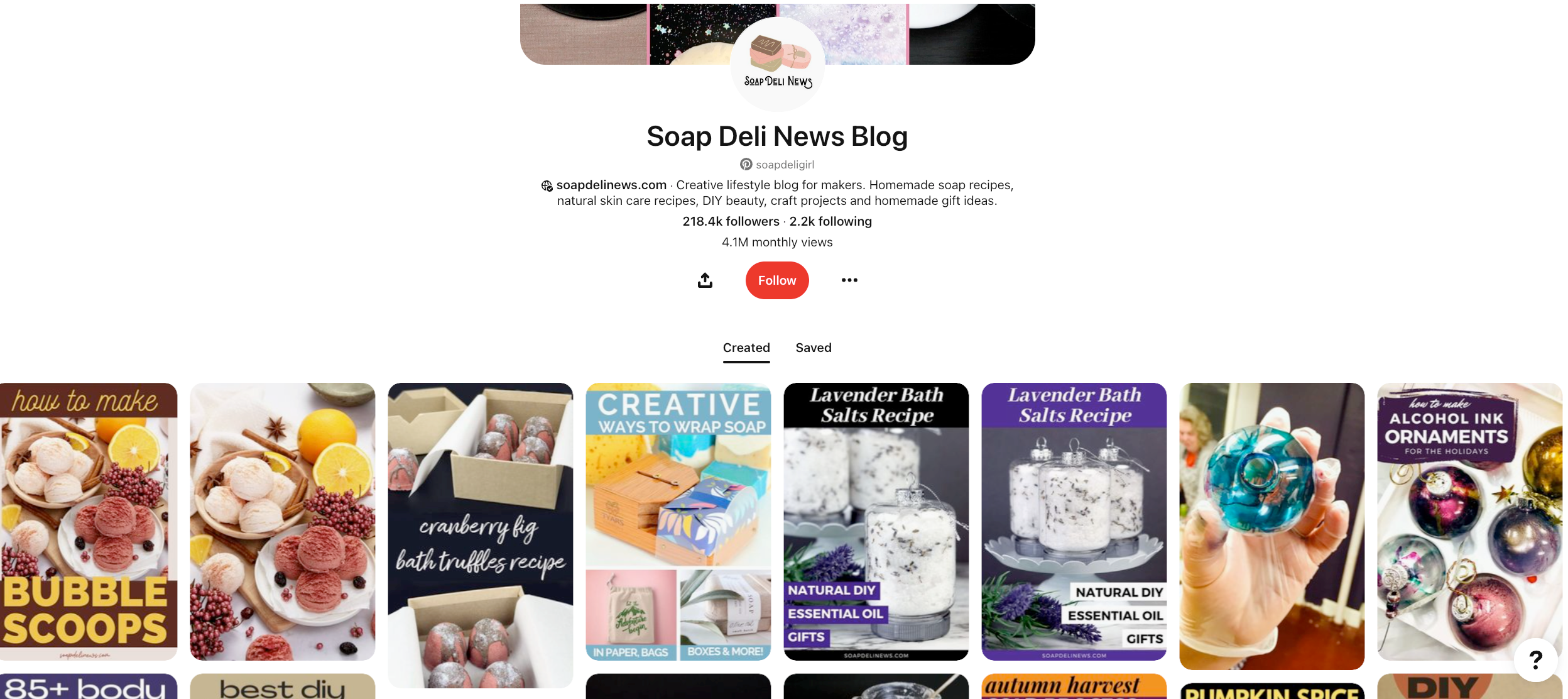
The DIY crafts and projects niche is a vibrant and creative space on Pinterest. It’s where imagination meets practicality, offering endless ideas for handcrafted decorations, homemade gifts, and creative hobbies. This niche appeals to crafters, hobbyists, and anyone looking to add a personal touch to their surroundings.
Why It’s the Best?
- Community Engagement: Encourages sharing of tips, tricks, and finished projects.
- Endless Creativity: Offers a vast array of project ideas, appealing to a wide demographic.
- Educational Aspect: Many users turn to Pinterest to learn new crafting skills.
- E-Commerce Opportunities: Links well with online stores selling crafting supplies and kits.
4. Wedding Planning and Inspiration (e.g., Katherines Corner)
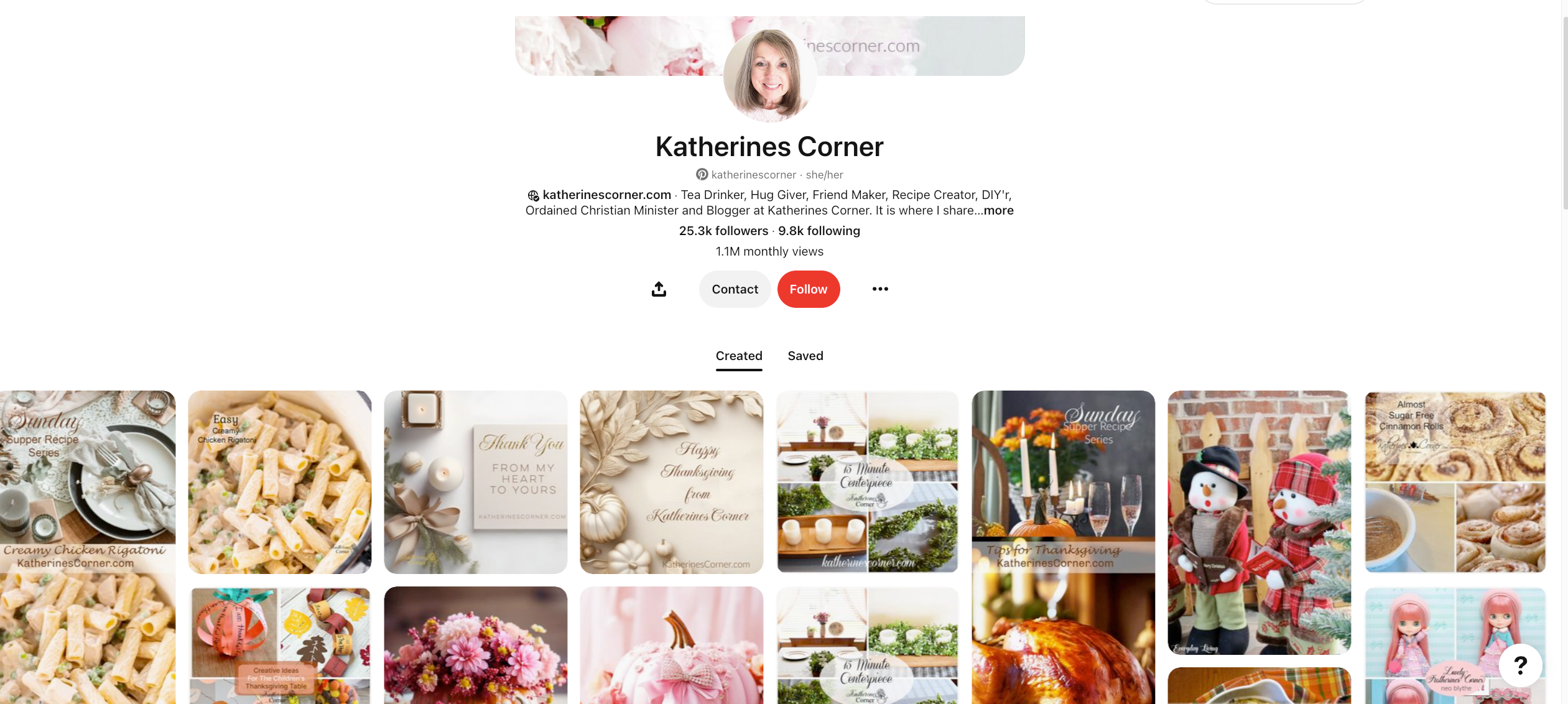
Wedding planning and inspiration is a niche that thrives on Pinterest. From dreamy wedding gowns to enchanting venue decorations, this niche offers a wealth of ideas for anyone planning their big day or simply dreaming about it.
Why It’s the Best?
- Visually Rich Content: Perfect for Pinterest’s image-centric approach.
- High Engagement: Users frequently save, share, and revisit wedding ideas.
- Broad Market Reach: Appeals to brides, grooms, planners, and dreamers alike.
- Sponsorship and Affiliate Opportunities: High potential for partnerships with wedding-related brands and services.
The Worst:
Pinterest niches with no potential include:
1. Overly Technical Content
While Pinterest is a hub for creativity and ideas, overly technical or complex topics struggle to gain traction. This is due to Pinterest’s user base primarily seeking visual inspiration rather than in-depth technical knowledge.
Why It’s the Worst?
- Mismatch with Platform’s Visual Nature: Complex data or text-heavy posts don’t resonate well.
- Limited Audience Appeal: Fails to engage the broader, visually-driven Pinterest community.
- Lower Shareability: Such content is less likely to be saved or shared.
- Challenges in Visual Representation: Difficult to represent technical data in an engaging, visual format.
2. Generic Fitness Routines
Generic fitness routines, without a specific focus or unique angle, often get lost in the sea of more targeted, niche fitness content on Pinterest.
Why It’s the Worst?
- High Competition: Oversaturated with many similar posts and ideas.
- Lack of Specialization: Fails to stand out to specific audience segments.
- Low Engagement: Generic routines inspire less interaction and enthusiasm.
- Poor Alignment with Audience Interests: Pinterest users often look for specialized or unique fitness ideas.
3. Abstract Art and Concepts
Abstract art and overly conceptual pieces, while valuable in artistic circles, don’t always resonate with the Pinterest community, which leans towards more practical and visually straightforward content.
Why It’s the Worst?
- Subjective Appeal: May not appeal broadly within Pinterest’s user base.
- Limited Practical Application: Lacks the ‘how-to’ aspect that many Pinterest users seek.
- Challenges in Audience Engagement: Abstract concepts can be harder for users to interact with or apply.
- Difficult to Categorize: Harder to fit into popular, searchable categories on the platform.
4. Corporate Branding and B2B Marketing
Corporate branding and B2B marketing content tend to underperform on Pinterest, a platform that thrives on personal inspiration and B2C engagement.
Why It’s the Worst?
- Mismatch with User Intent: Pinterest users typically seek personal inspiration, not corporate messaging.
- Lower Engagement: B2B content often fails to inspire the level of engagement seen with B2C content.
- Platform Dynamics: Pinterest’s strength lies in individual and consumer-focused content rather than corporate.
- Limited Virality: Corporate content is less likely to go viral or be widely shared among Pinterest users.
In exploring these less successful niches on Pinterest, I’ve learned the importance of aligning content with the platform’s strengths and user preferences. Just as a painter chooses the right canvas, selecting the right niche for your content on Pinterest can make all the difference.
Facebook Niches
As we navigate to Facebook, a giant in the social media landscape, the dynamics shift. Facebook, with its diverse user base, offers a unique environment where both personal and professional content can thrive. It’s a platform where community engagement and social interaction take center stage. Here, some niches naturally flourish, while others face challenges in gaining traction.
Let’s explore the best and worst niches on Facebook, understanding what makes them click or fall flat in this ever-evolving social space.
The Best:
The best Facebook niches are:
1. Local Community and Event Groups (e.g., EventProfs Mastermind for Event Planners)
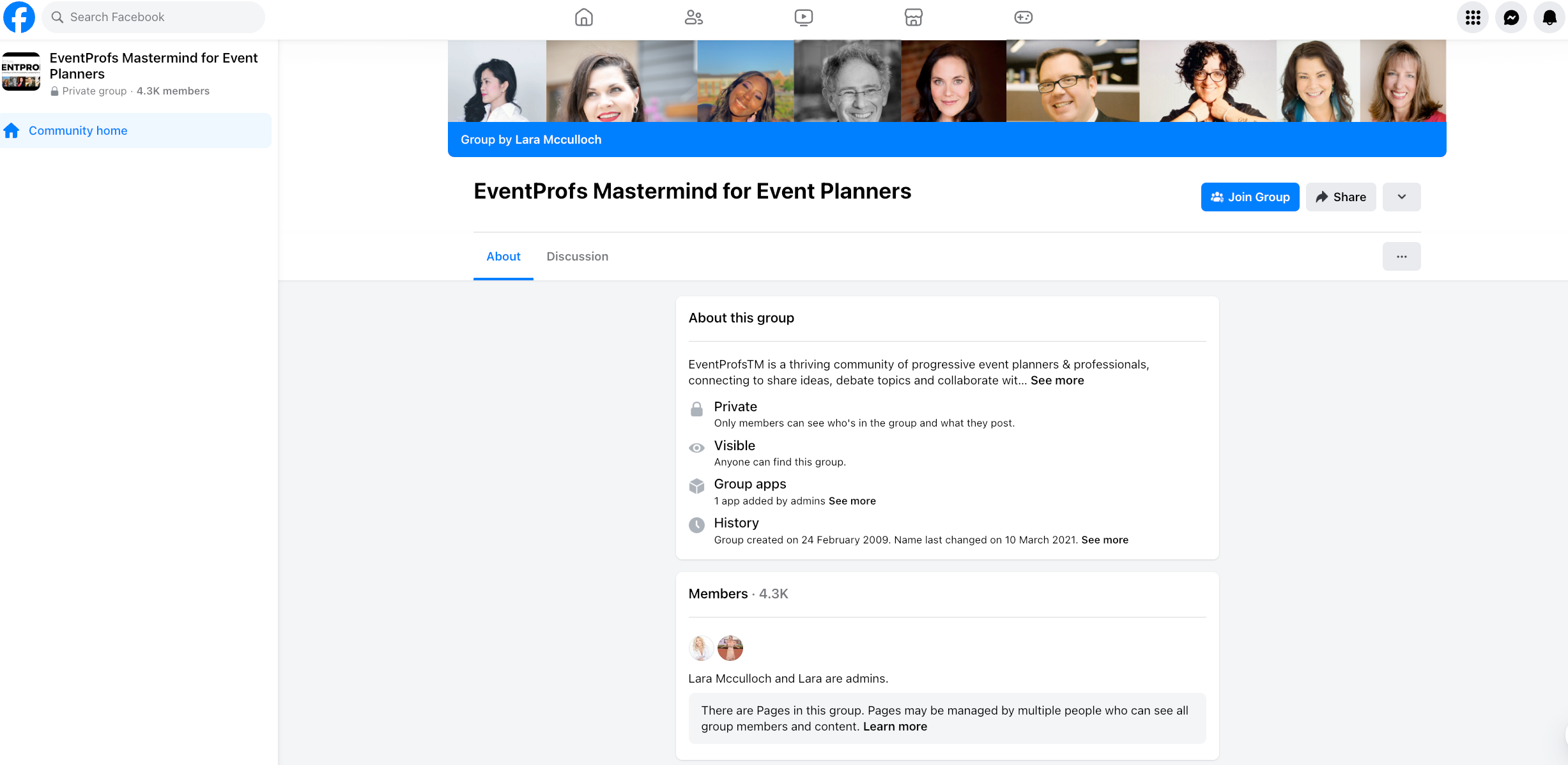
Local community and event groups thrive on Facebook, leveraging its strong community-building features.
Why It’s the Best?
- Community Engagement: Ideal for fostering local interactions and community spirit.
- Event Promotion: Effective for spreading the word about local events or gatherings.
- High Relevance: Content is highly relevant to the group members, driving engagement.
- Networking Opportunities: Great for connecting people with shared interests or needs.
2. Niche Hobby and Interest Pages (e.g., Car Drawing by Floridi Diego)
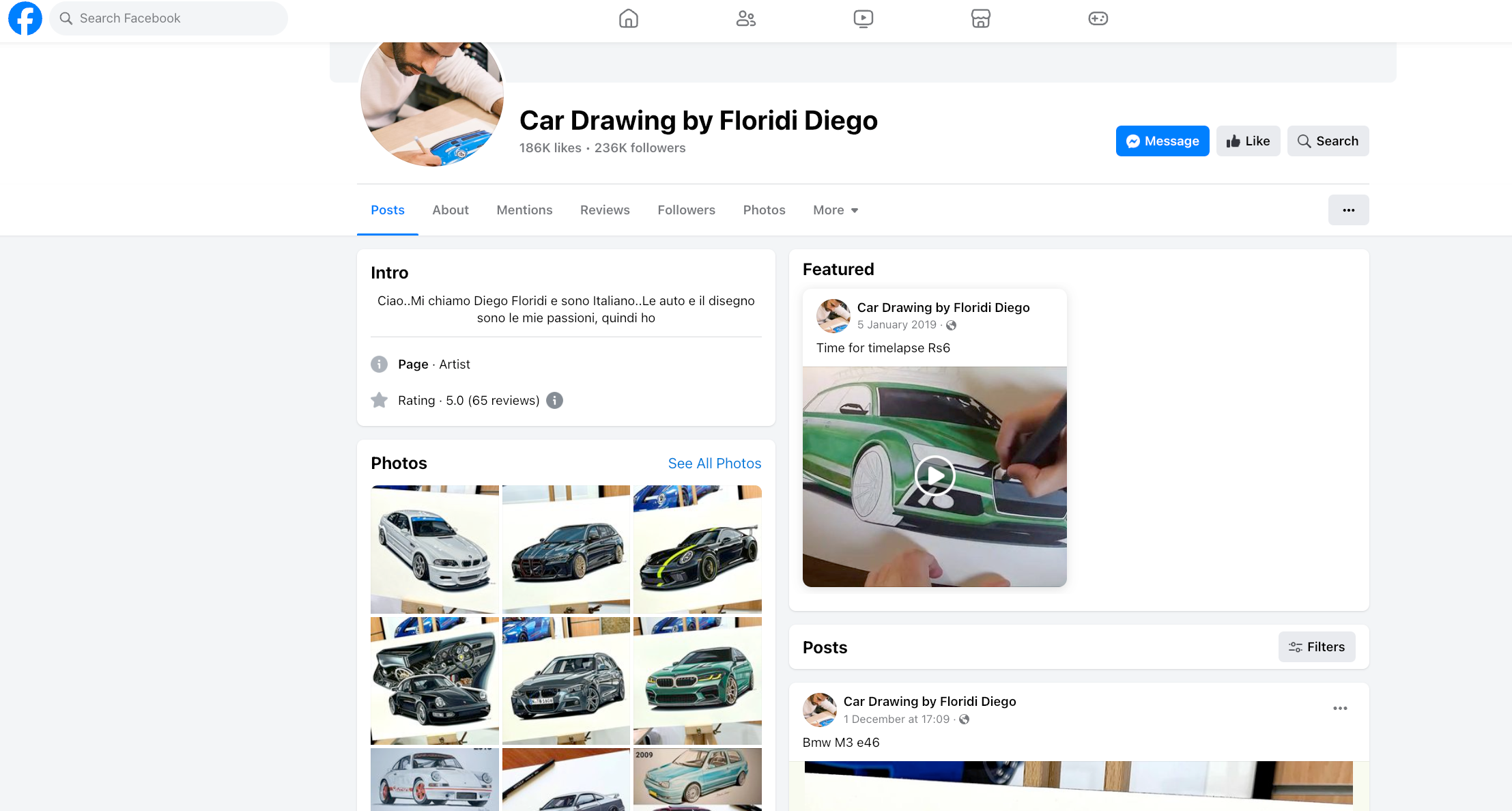
Pages centered around specific hobbies or interests find a dedicated and passionate audience on Facebook.
Why It’s the Best?
- Targeted Audience: Connects people with shared hobbies or interests.
- Active Participation: Encourages discussions, sharing of tips, and experiences.
- Member Loyalty: High retention as members are invested in their interests.
- Diverse Content Sharing: Allows for a variety of content types, from photos to long-form posts.
3. Educational Content and Support Groups (e.g., Cult Of Copy Job Board)
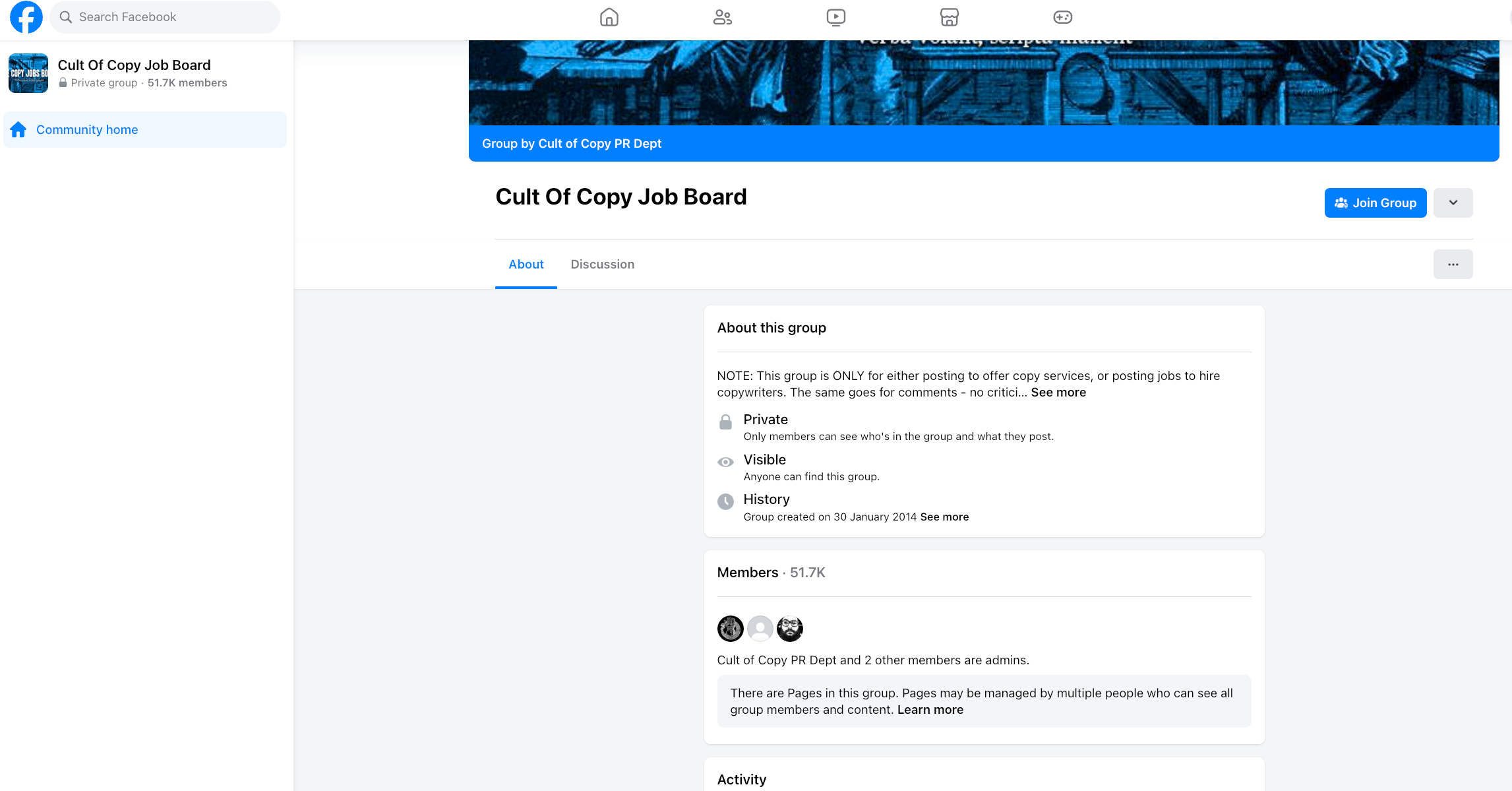
Educational content and support groups offer a platform for learning and community assistance, resonating well with Facebook users.
Why It’s the Best?
- Information Sharing: Facilitates the exchange of educational materials and resources.
- Supportive Community: Offers a space for seeking advice and support.
- Diverse Demographics: Attracts a wide range of users, from students to professionals.
- Engagement Through Learning: Encourages active participation through questions and discussions.
4. Business and Brand Pages (e.g., Budweiser)
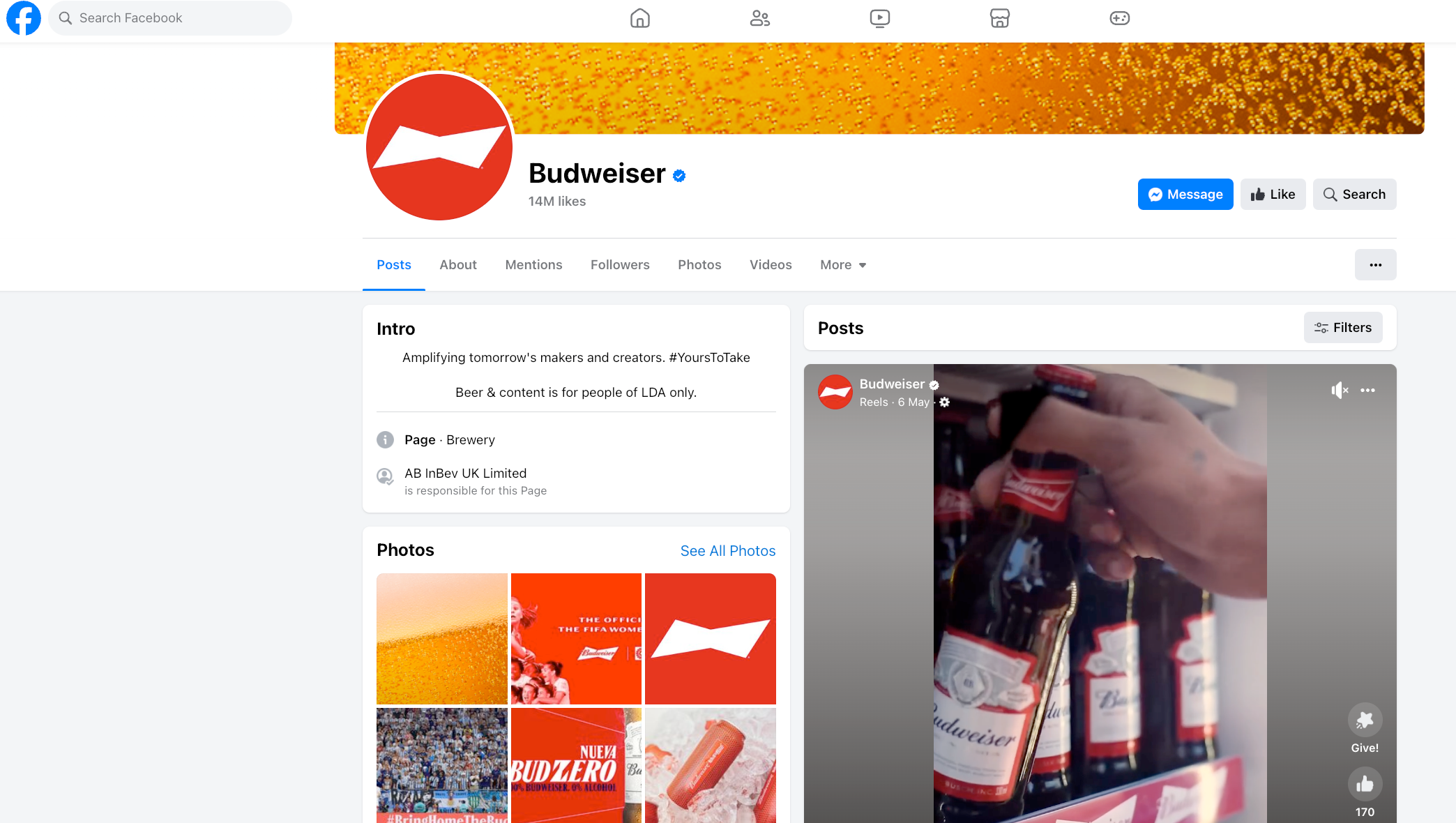
Business and brand pages, especially for small and local businesses, effectively use Facebook to connect with their audience.
Why It’s the Best?
- Brand Visibility: Enhances online presence and reach.
- Customer Interaction: Direct line to customers for feedback and engagement.
- Marketing and Sales: Effective for promotions, updates, and even direct sales through Facebook Marketplace.
- Analytical Insights: Provides valuable data on audience engagement and preferences.
The Worst:
Some worst Facebook niches are:
1. Highly Specialized Academic Topics
Highly specialized academic topics often struggle to engage the broader Facebook audience.
Why It’s the Worst?
- Niche Audience: Limited appeal to a broader user base.
- Lower Engagement: Complex topics may intimidate or alienate the average user.
- Content Limitations: Facebook’s format may not be ideal for in-depth academic discussions.
- Visibility Challenges: Harder to get noticed amidst more universally appealing content.
2. Overly Promotional Business Pages
Business pages that focus too heavily on sales and promotions without offering value can turn off Facebook users.
Why It’s the Worst?
- User Disinterest: Facebook users often seek engagement, not constant sales pitches.
- Low Engagement: Over-promotion can lead to reduced interaction and unfollows.
- Trust Issues: Too much selling can erode trust and authenticity.
- Algorithm Disadvantages: Facebook’s algorithm may reduce the visibility of overly promotional content.
3. Politically Charged Content
Politically charged content can create divisiveness and often faces backlash or reduced engagement on Facebook.
Why It’s the Worst?
- Polarizing Nature: Can lead to heated debates and negative interactions.
- Community Guidelines: Risk of violating Facebook’s community standards.
- Brand Risk: Potential to alienate parts of the audience.
- Engagement Quality: Engagement may be high, but not necessarily positive or productive.
4. Generic Motivational Quotes
While motivational quotes are popular, generic and overused quotes fail to stand out and engage deeply on Facebook.
Why It’s the Worst?
- Oversaturation: Too common, leading to a lack of uniqueness.
- Low Engagement Depth: Likes may be easy, but deeper engagement is rare.
- Limited Branding Opportunity: Hard to build a unique brand identity around generic content.
- Reduced Shareability: Users are less likely to share content that doesn’t stand out.
Exploring Facebook’s niches reveals the importance of community engagement and value-driven content. It’s not just about what you post, but how it resonates with and unites the audience.
TikTok Niches
As we step into the world of TikTok, it’s like entering a vibrant, fast-paced arena where trends are born and creativity is king. TikTok, known for its short-form video content, captivates a largely younger audience with a wide range of interests. This platform is a hotbed for viral content, where unique and engaging niches can skyrocket to fame overnight.
However, not every niche finds its footing in TikTok’s dynamic environment. Let’s dive into the best and worst niches on TikTok, examining what makes them flourish or flounder in this ever-changing landscape.
The Best:
The best TikTok niches with high potential are:
1. Dance and Music Challenges (e.g., Noel Robinson)

Dance and music challenges are quintessential to TikTok, often becoming viral sensations.
Why It’s the Best?
- Viral Potential: High likelihood of trending and gaining widespread popularity.
- Community Participation: Encourages user engagement and participation.
- Cross-Promotion: Artists and creators can promote their music and dance moves.
- Fun and Inclusive: Accessible to a wide range of users, regardless of skill level.
2. Comedy and Skit Content (e.g., The McFarlands)
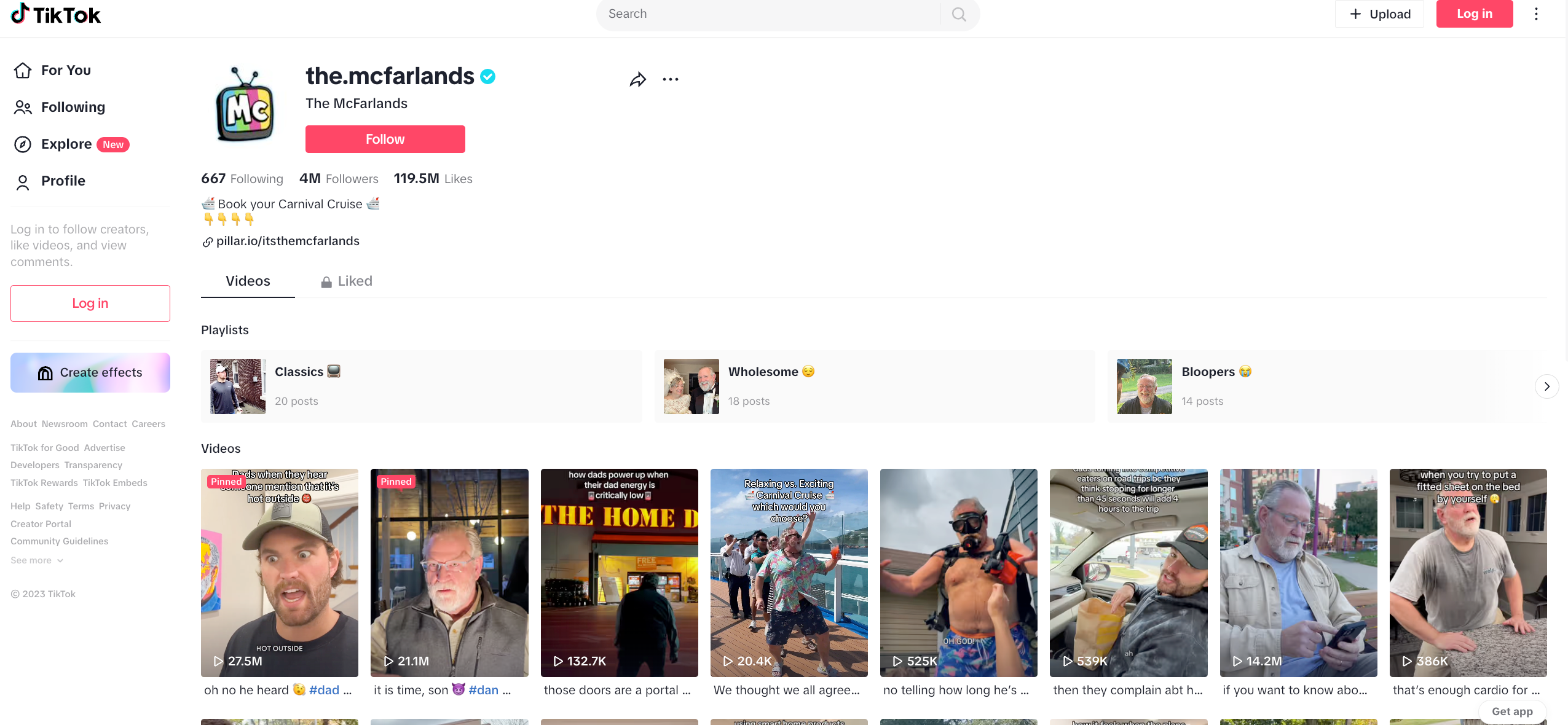
Short, humorous skits and comedy clips are a massive hit on TikTok, resonating with its fun-loving audience.
Why It’s the Best?
- High Engagement: Laughter is universal, driving likes, shares, and comments.
- Creative Freedom: Allows for a wide range of creativity and personal expression.
- Broad Appeal: Humor appeals to a diverse audience, cutting across demographics.
- Shareability: Funny content is highly shareable, increasing reach and visibility.
3. Beauty and Fashion Tips (e.g., Finlea Ryan)
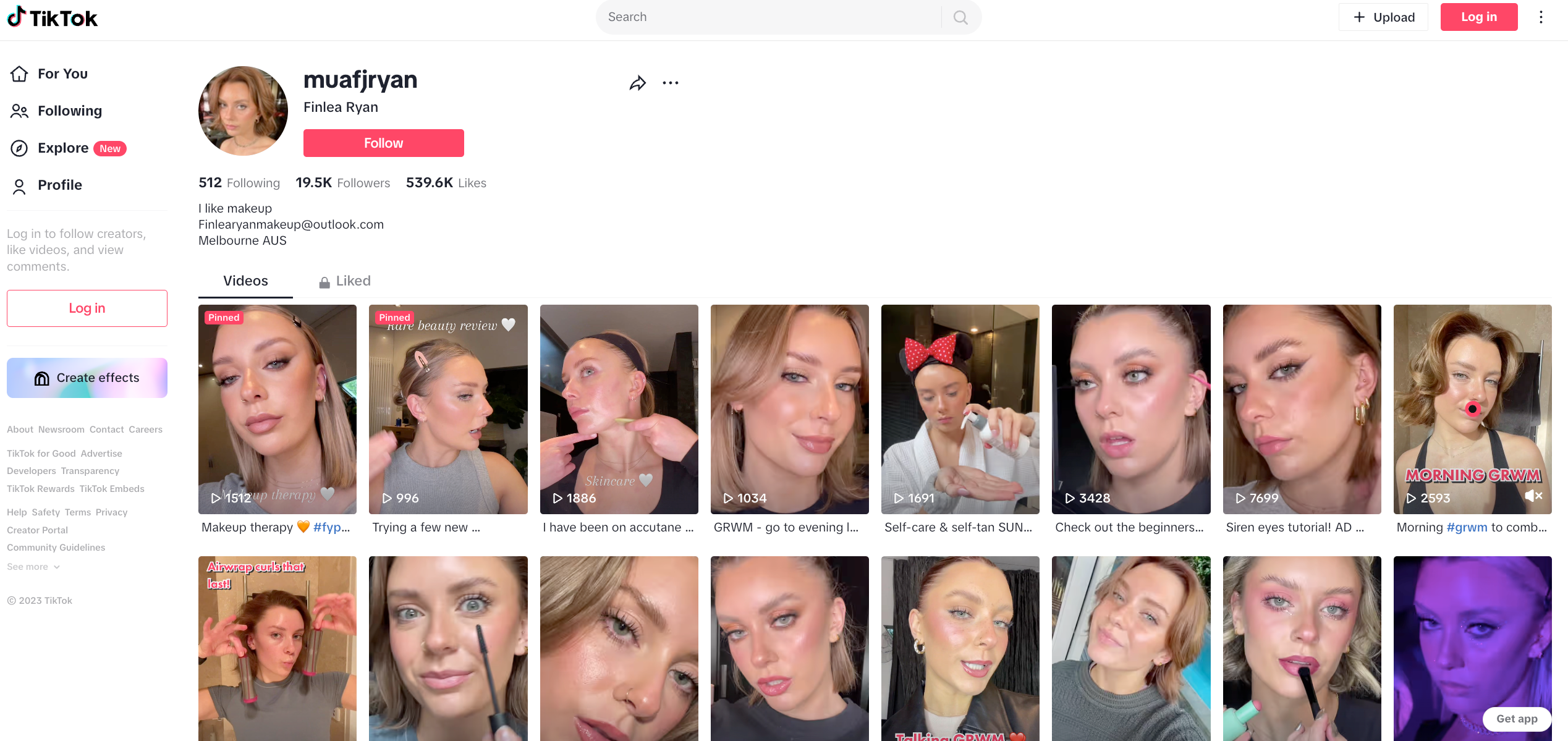
When it comes to influencer niche ideas, beauty and fashion tips, including quick tutorials and product reviews, thrive on TikTok.
Why It’s the Best?
- Visual Appeal: Perfectly aligns with TikTok’s visually-driven format.
- Influencer Collaborations: Opportunities for partnerships with beauty and fashion niche brands.
- Trendsetting: A platform to showcase the latest styles and beauty niche hacks.
- High User Interest: Consistently high interest in beauty and fashion content among TikTok users.
4. DIY and Life Hacks (e.g., The Shk Facts)
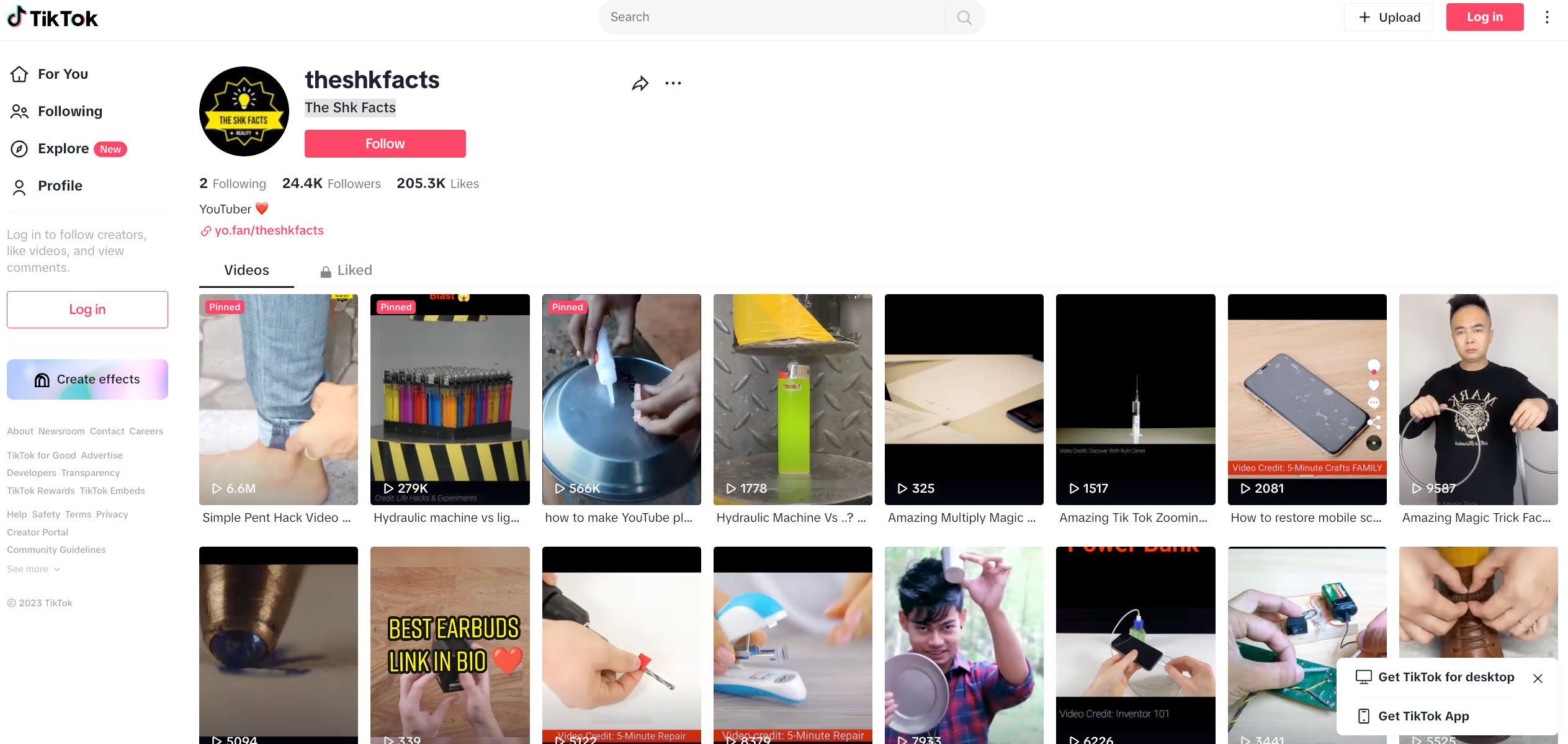
Practical and clever DIY projects and life hacks captivate TikTok users with their usefulness and creativity.
Why It’s the Best?
- Practical Value: Offers useful tips and tricks that users love to try and share.
- Creative Showcase: Allows creators to showcase their ingenuity and creativity.
- Engagement through Utility: Practical content drives likes and shares as users find it helpful.
- Diverse Topics: Covers a wide range of subjects, appealing to varied interests.
The Worst:
On the other hand, here are TikTok niches with low potential of growth:
1. Overly Technical or Educational Content
Deeply technical or traditional educational content often struggles to engage TikTok’s audience, geared towards entertainment and quick consumption.
Why It’s the Worst?
- Mismatch with User Expectations: Users generally seek entertainment, not in-depth learning.
- Content-Length Limitations: Complex topics are hard to convey in short video formats.
- Lower Engagement: Such content typically receives fewer views and interactions.
- Audience Demographics: TikTok’s younger audience may not resonate with highly educational material.
2. Lengthy Storytelling or Vlogs
Extended storytelling or vlogging faces challenges on TikTok, a platform known for its bite-sized content.
Why It’s the Worst?
- Format Constraints: Long narratives are difficult to fit into TikTok’s short video format.
- Audience Preference: Users favor quick, engaging content over lengthy stories.
- Competitive Disadvantage: Struggles to hold attention in a fast-paced scrolling environment.
- Reduced Shareability: Longer content is less likely to be shared compared to snappier clips.
3. Overly Niche or Obscure Topics
Extremely niche or obscure topics can have a hard time finding a broad audience on TikTok.
Why It’s the Worst?
- Limited Audience Reach: Very specific topics appeal to only a small group of users.
- Engagement Challenges: Harder to generate widespread interest and engagement.
- Discoverability Issues: Such content may not surface on the majority of users’ ‘For You’ pages.
- Viral Unlikelihood: Unlikely to go viral or gain significant traction.
4. Heavy and Serious Themes
Content with heavy or serious themes often doesn’t resonate well on TikTok, where users primarily seek light-hearted and entertaining material.
Why It’s the Worst?
- Contrast to Platform Mood: TikTok’s atmosphere is predominantly upbeat and fun.
- Engagement Difficulty: Serious themes may not inspire the level of engagement seen with lighter content.
- Audience Mismatch: May not align with the preferences of TikTok’s younger user base.
- Viral Hurdles: Less likely to go viral in an environment that favors more lighthearted content.
Exploring the niches of TikTok reveals the platform’s penchant for quick, engaging, and visually appealing content. Understanding what resonates with the TikTok audience is key to making a mark on this dynamic platform.

Pro tip: How Do I handle several platforms efficiently?
Navigating the world of content creation can sometimes feel like juggling too many balls at once, right? It can get a tad overwhelming between brainstorming fresh content ideas and trying to be everywhere at all times. That’s where handy management tools come into play.
Think of these tools as that reliable friend who’s got your back – helping you plan out your content, reminding you when to post, and even giving you little insights about what’s working. With a pal like this by your side, you can save heaps of time and keep your focus on what you love: creating amazing content. And as a sweet bonus? Your channel grows while you’re at it! Cheers to smart work and more “me” time!
These are some features that management tools can offer to help you grow your channel more efficiently:
1. Content Scheduling and Planning
2. Analytics and Performance Metrics
3. Visual Content Calendar
4. Hashtag Suggestions
5. Multi-platform Management
6. User-Generated Content Features
I have tried many of these tools, and my personal recommendation is Publer.io because it streamlines content scheduling and analytics, paving the way for enhanced engagement and growth. This tool is like your personal assistant for social media growth. You’re not just posting content; you’re strategically boosting your reach and engagement. It helps you understand what your audience loves, fine-tuning your content to their preferences. Plus, it’s incredibly user-friendly!
Imagine having more time to focus on creativity while Publer.io handles the growth tactics. It could be the secret ingredient you need to see your TikTok channel thrive. But you do not need to take my word for it. I invite you to check what people are saying about this tool in Trustpilot:

So now, it is up to you to check if Publer might be the right tool to help you grow. You can check their features and prices here.
Wrapping It Up: Your Social Media Niche Guide
We’ve journeyed through the diverse world of the most profitable niches on social media platforms, uncovering the best and worst for each platform. It’s been an enlightening ride, hasn’t it? From YouTube’s educational content to TikTok’s dynamic dance challenges, each platform offers unique opportunities and challenges. Remember, finding your niche is key to standing out in the crowded social media space.
Key Takeaways:
- YouTube thrives on educational, tech, health & fitness, and travel profitable niches.
- Instagram thrives on travel photography, fashion influencing, food photography, and fitness journeys.
- Pinterest favors home decor, wellness recipes, DIY crafts, and wedding planning.
- Facebook is ideal for local communities, niche hobbies, educational content, and business pages.
- TikTok shines with dance/music challenges, comedy, beauty/fashion tips, and DIY hacks.
- Avoid niches that don’t align with the platform’s strengths or audience interests.
As I conclude, keep in mind that success on social media is not just about choosing the right niche; it’s about creating content that resonates with your audience and harnesses the unique strengths of each platform. Your journey in the social media landscape is a continuous learning process, filled with opportunities to adapt, grow, and connect, like choosing faceless niches versus traditional niches.. So, go ahead, find your profitable niche, and make your mark.
